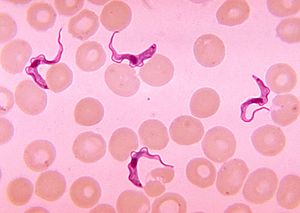Trypanosoma facts for kids
Quick facts for kids Trypanosoma |
|
|---|---|
 |
|
| Trypanosoma sp. among red blood cells. | |
| Scientific classification |
|
| Domain: | Eukaryota |
| Phylum: | Euglenozoa |
| Class: | Kinetoplastea |
| Order: | Trypanosomatida |
| Family: | Trypanosomatidae |
| Genus: | Trypanosoma Gruby, 1843 |
| Subgenera | |
|
|
| Synonyms | |
|
|
Trypanosoma are tiny, single-celled living things. They are a type of protozoa, which are like very simple animals. These tiny creatures are also parasites. This means they live inside another living thing, called a host, and get their food from it.
All Trypanosoma need more than one host to complete their life cycle. They often move between different types of animals. For example, they might live in an insect and then move to a mammal.
How Trypanosomes Spread
Most Trypanosoma are spread by a vector. A vector is an animal that carries a disease from one host to another. For Trypanosoma, these vectors are usually invertebrates. This means animals without a backbone, like insects.
These insects often feed on blood. When they bite, they can pass the Trypanosoma from one animal to another. Different types of Trypanosoma spread in different ways.
Where They Live in Hosts
When Trypanosoma live in an invertebrate host, like an insect, they are usually found in the insect's intestine. But when they move to a mammalian host, like a human or another animal, they live in different places.
In mammals, they often live in the bloodstream. This is the blood that flows all around your body. Sometimes, they can also live inside the cells of the host.
Diseases Caused by Trypanosomes
Trypanosoma can infect many different hosts. They cause various diseases in both animals and humans. Some of these diseases can be very serious.
One well-known disease is sleeping sickness. This disease affects humans and is caused by a type of Trypanosoma called Trypanosoma brucei. It is found in parts of Africa. Another important disease is Chagas disease. This disease is caused by Trypanosoma cruzi and is common in Central and South America.
These diseases can make people very sick. Scientists and doctors work hard to understand and treat them.
See also

- In Spanish: Trypanosoma para niños

